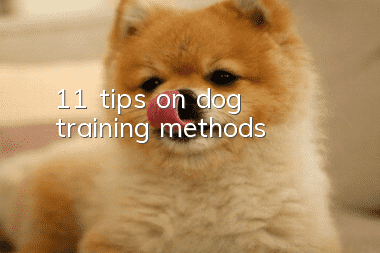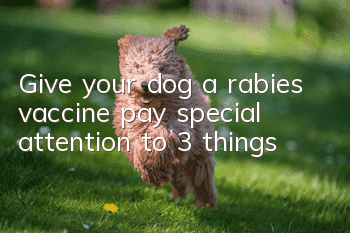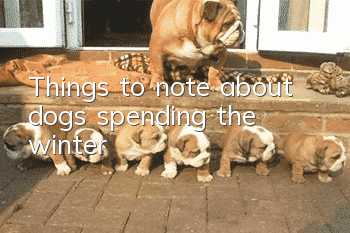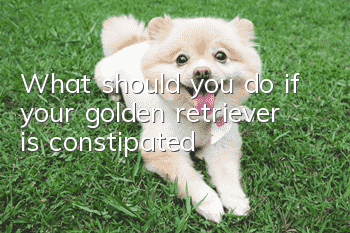11 tips on dog training methods

1. Excretion training must be started earliest, but it is also the most controversial training, which is to train the puppy to excrete outside the house. Elimination training is the best time to use positive reinforcers, that is, various food and toy rewards. In addition to rewarding your pet when it does something right to reinforce the behavior, another tip is to predict when your pet will eliminate. Dogs usually excrete after walking, eating, drinking or playing, or when you are not careful. If you want to make training effective, you must carefully observe the dog's eating and drinking situation, and set up a safe zone. , that is, a place where dogs will never poop. The most ideal safe area is the dog's kennel. If there is no dog cage at home, try to let the puppy go to bed in the bathroom or laundry room. 2. Puppy obedience Using puppy obedience is an interesting topic in training. Puppies are generally not considered ready for formal training until they are six months old. However, many puppies often learn some bad behaviors before they are six months old. A puppy thought to be incapable of learning to sit still can learn to chew up every shoe it finds or jump on every guest. The misunderstanding that puppies can only learn [bad] behaviors but not [good] behaviors is the root of this contradiction. The solution lies in a thorough review of the methods used to teach puppies, rather than doubting their ability to learn. Traditionally, dog training methods have focused on forcing the dog to obey. Although [force] is an effective tool for punishing serious misconduct, it is done by force. Trying to get your dog to learn new behaviors doesn't work that well. This forced method tends to suppress all behaviors regardless of good or bad, not just bad ones; imposing too much training on a dog too early may lead to training failure. To avoid this situation, you should focus on using positive rewards to train correct behaviors. 3. New tools Everyone knows that when training a dog, someone must clearly tell the dog "No!" ] signal. In fact, when the dog does something right, a signal that praises the dog "is so good" is equally important. If there is no such signal, it is equivalent to forcing the dog to guess which behavior will be rewarded. This kind of trial and error method takes a lot of time before the dog accidentally guesses it correctly, and there is no reward during the trying process. Think about it: there is no reward, and it takes a long time to try to succeed; the puppy naturally chooses to give up learning, and even decides that [learning] is not worth the gain. A simple "good boy" signal can quickly make the puppy confirm that he has done the right thing, and also make him feel that the reward is not out of reach; naturally, the puppy will also like to learn more. 4. Associate signals with rewards. The first step to make the signal "good dog" effective is to choose a short, easy-to-recognize password. A simple example is to shorten sentences like "Good dog, good puppy, mommy's little baby" into a password like "Good". At the beginning, while saying "Be good", you should give the puppy something to eat. Repeat this about twenty times. Notice:The order of saying "good" first and then giving food is very important; pause slightly between saying "good" and giving food. Soon, the puppy will respond to the password you choose and start to expect you to give it a reward. In other words, you have successfully created the password "good". Now you have a powerful tool that can quickly tell your dog that he did something right. 5. Use objects: Most puppies will resist unhappily when they are forced to sit down. A better approach is to trigger the dog's instinct to follow the target. When a person holds some food and puts it in the puppy's nose, it will naturally turn its head as the food moves; if the food moves away, the dog will stand up and follow the food forward. We can try this method to train the puppy to "sit down", and we will discover the advantages of this method. First, find a piece of food that your puppy likes to eat and is of a suitable size. Remember, don’t choose a dog biscuit that is too hard or something that is too chewy. Because the dog may spend a lot of time chewing the prize hard, making the training progress too slow. Sit in front of the puppy and place the food between its nose and forehead. Don't move the food too quickly so that your puppy can't find it. Also, don't lift the food above the dog's head, otherwise the dog may try to stand up on its hind feet instead of sitting down. If your puppy tries to jump on you or pounce on the food, say "Wrong" in a normal tone and take the food back quickly. If you are lucky, the puppy will naturally lean back following the food and sit down. As soon as it sits down, say "Good" to it and then give it food. Don't be discouraged if your dog doesn't sit down; some puppies will naturally back away or even stand up to get to the treat. Generally speaking, when trying to train a dog to do a certain action for the first time, if the puppy does not do the complete set of actions, try to let it do part of the action. Take training a dog to sit down as an example. If its hind legs relax when you lift the food above its nose, you should praise it for being "good" and give it the food. Continue the same training and try to relax the dog's hind legs more each time. If this continues, the dog will slowly learn to sit down. Try not to lose patience, or press your puppy's back to get him to sit. The significance of this training method is to induce the puppy to learn with [rewards] rather than forcing the puppy. If you are successful in getting your puppy to sit every time, you can move on to the next step in training. Follow the steps below and you will soon get surprising results: 1. Say "Sit" to the puppy 2. Move the food in front of its forehead (the puppy should sit down at this time) 3. Praise It is [very well behaved] 4. Give it food. This exercise can easily be extended to the "stop in place" movement. This is done by pausing for a few seconds or taking a step or two back before you say "good". If your dog wants to stand up before you say, "Good," say, "Wrong," and then do it again. If the dog stops in one place, say "Good boy" to it. and give it a prize to let it know you like itWhat to do. The secret is: Don’t keep saying: “Sit, sit, sit” to your dog. Just say it once. The goal of this training is that the dog will respond immediately as soon as you say the command, instead of taking action after saying it twice or three times. Don't yell at the dog like the squad leader in the army. This can prevent the dog from being timid and make it feel that learning is an interesting experience. 6. Training the puppy [come over] Training the dog to come towards you when you call it is an important behavioral training. The following steps can be quickly learned by your dog: 1. Ask the puppy to sit down. 2. Take a step back. 3. Say "come" to the puppy. 4. Place the prize at your feet and make sure the dog sees the prize. 5. The puppy should now get up and come over, wanting to eat the prize. 6. Before the puppy's mouth touches the prize, say "Good boy" to it. 7. Gradually increase the time the puppy sits still and the distance between the prize and the puppy. 8. Try saying "come" to your puppy outside of training. 7. How to use punishment When training a puppy, you must establish the concept that "punishment is used to correct inappropriate behavior". [Penalty] has become almost a taboo over the past few years. Many people mistakenly believe that punishment is cruel or even a useless training tool. In fact, as long as punishment is applied in the correct way and at the right time, it is quite effective when it is used to prohibit a puppy from doing a certain behavior. Traditional punishments are usually given long after the dog has made a mistake, and then at will according to the owner's mood. These old-fashioned punishment methods are not so much training as retaliation for the dog's disobedience. People who train puppies with completely positive rewards are certainly very respectable, but there are even fewer people who know how to use punishment correctly and achieve training goals. In a state of frustration at failed training, most owners will resort to old-fashioned punishment, such as spanking their dog. Ironically, although social climate has changed and traditional punishment methods are no longer used, examples of animal cruelty continue unabated. To resolve this contradiction, we must rethink our moral outlook on [punishment] and how to correctly use this powerful training tool. We usually think that people with high moral standards would never inflict pain on their puppies. But this argument is good in theory, but impossible in practice. Let’s take a puppy to the veterinarian as an example: we ask the veterinarian to give the puppy injections, draw blood, and touch it roughly. When the puppy is old enough, we may even have to have it stabbed and sterilized. If we still insist on [not letting puppies suffer], it is really a kind of hypocrisy. We will make dogs uncomfortable or even painful for health reasons; but we are unwilling to punish puppies for training requirements. To change this prejudice, we must revise our moral values and adopt the principle of "doing no harm to dogs" instead of hypocritically insisting on "doing no pain to dogs". 8. Correct the habit of jumping on people. For example, if you want to correctly change the habit of a dog jumping on guests, you don’t have to hurt it. First, you have to find something your dog really doesn't like - like a water gun or a spray can filled with water. Then,Try to make the puppy associate the water gun with the signal "Don't do this again" (you can use the "No" command). The command "No" is telling the puppy that "this behavior will be punished". The timing of "No" is very important: you must tell the puppy the moment it makes an incorrect action. The action of spraying water can be delayed for a few seconds before doing it. For example: a puppy jumps on people - 1. The puppy starts to jump 2. Say "No" to it 3. Spray water on the puppy 4. Ignore it for the time being (about one to two minutes) 5. Continue this process , until the dog stops jumping. 6. When the puppy starts jumping again, say "sit" to it; if it sits down obediently, give it a reward. It should be noted that although the general training rule is to reward the puppy when it does something right; in fact, if the dog accidentally associates this reward with the wrong behavior pattern, it will cause problems. For example: the puppy jumps on the mother, the mother yells "No" and sprays water on the puppy. The puppy sits down obediently, and the mother rewards it. In this way, the dog may mistakenly believe that as long as it can endure the feeling of being sprayed, it will be rewarded by its owner. A better approach is to wait until the bad behavior is completely corrected before giving rewards to strengthen the impression. 9. Prevent puppies from biting. Another situation where punishment-based education methods are applicable is to prevent dogs from biting. To prevent your puppy from biting, the first line of defense is to keep your dog away from things it shouldn’t bite. Put your shoes in the shoe cabinet and close the door; put expensive books on the bookcase, not on the coffee table. In short, just put away every precious thing and keep it away from the puppy. But while putting things away is a good idea, this approach has two fatal drawbacks. First of all, this does not teach the puppy to avoid dangerous things and places. Second, most owners underestimate a puppy’s ability to find chews. The only way to ensure a safe environment for your dog is to teach it what things it can play with safely and what things it should stay away from. The first step in training is to teach the dog the command "No". Whether the time to say "no" is correct or not is an important factor in whether the puppy can understand why it is being punished. There is a good training item that can be used for this training-extension cord. Electrical wires covered with rubber insulators are one of the most dangerous things to an unsuspecting puppy. To a puppy, the touch and bite of an extension cord are the same as those of ordinary electrical appliances.
- Does Doberman recognize his master?
- Small black spots around dog urethra
- What should I do if my dog drinks milk tea?
- What to do if your dog eats sugarcane bagasse
- What dogs are pit bulls most afraid of?
- Why is my puppy nauseous and vomiting?
- Can dogs eat salt? Salt supplementation is really not suitable for dogs!
- Can dogs eat yogurt? Try to avoid lactose intolerance!
- Can dogs eat red beans? It’s best to eat less!
- What's going on with Taobao's free adoption of pet dogs? It's all fake!



